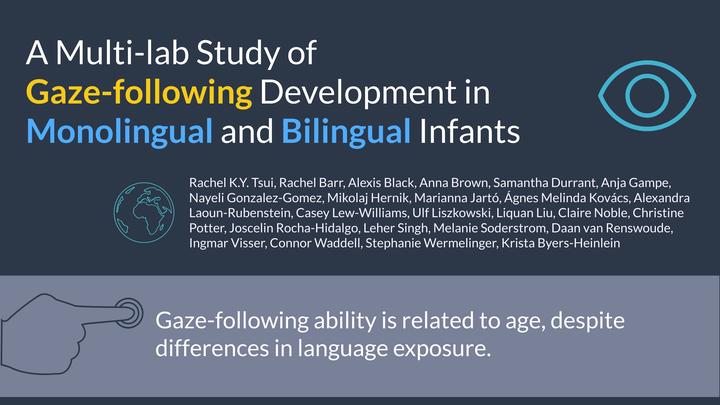
Abstract
The ability to follow another’s eye gaze is an important skill for social interaction and learning. For example, in word learning, gaze-following allows infants to map a word onto the object a speaker is referring to (e.g., Paulus & Fikkert, 2014). Several studies have shown that by 6 months, infants follow a speaker’s eye gaze at above-chance levels, but their performance is not always reliable (Gredebäck, 2018; Senju & Csibra, 2008; Szufnarowska et al., 2014). Different approaches to measuring eye gaze may vary in sensitivity: Senju and Csibra (2008) found above-chance gaze-following when measuring infants’ first look and frequency of looks to the gazed-at object, but not when measuring the total duration of infants’ looks. The current study investigated how a variety of metrics might inform our understanding of the development of early gaze-following. Moreover, we tested two potential developmental contributors to infants’ gaze-following abilities. First, we investigated age-related changes and expected older infants to show more reliable gaze-following than younger infants. Second, we investigated whether language experience could affect the development of gaze-following. Research with preschoolers suggests that bilinguals show more use of eye gaze cues in word learning than monolinguals, presumably because bilingual environments engender more referential complexity (e.g., Brodje et al., 2012; Yow et al., 2017). We thus hypothesized that bilingual infants might show a gaze-following advantage relative to monolinguals. To collect the large-scale data needed to address these questions, we used a multi-lab collaborative approach. 322 infants (131 bilinguals and 191 monolinguals) from 11 labs in 8 countries were tested using automatic eye-tracking or offline manual coding. Monolingual and bilingual infants of 6–9 and 12–15 months were compared on their latency and accuracy of gaze patterns using the eye gaze stimuli from Experiment 1 in Senju and Csibra (2008). On six test trials, infants saw videos of a female actor looking towards the camera and then directing her head and eyes towards one of the two objects located on her left and right. We conducted mixed-effects regressions and meta-analytic models to assess effects of age and bilingualism on (1) proportion of first look towards the congruent (i.e., gazed-at) object over the incongruent object, (2) frequency of looks to the congruent and incongruent objects, and (3) duration of fixations. We also investigated whether (4) latency of first look to the congruent object might change across development. Overall, first look and frequency of congruent looks appeared to be more sensitive measures than duration of fixations or latency. First look and frequency of looks revealed that infants of both ages successfully followed the actor’s gaze, and this ability improved with age (Figures 1 and 2). However, contrary to predictions, monolingual and bilingual infants performed nearly identically. Together these findings revealed that, independent of monolingual or bilingual status, early gaze-following development is significantly modulated by age-related changes. Our results also brought new insights to gaze-following research by highlighting that two measures—location of first look and frequency of looks—were more robust in evaluating early gaze-following patterns.